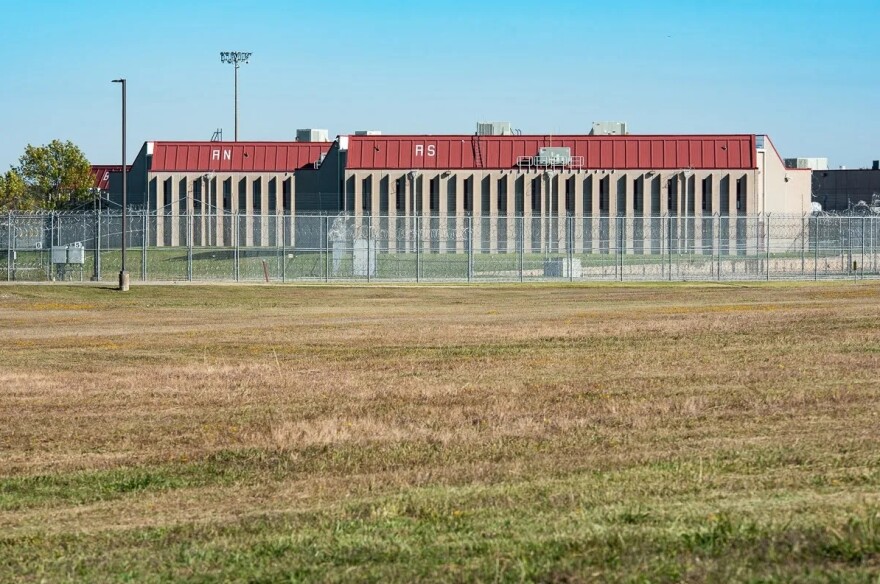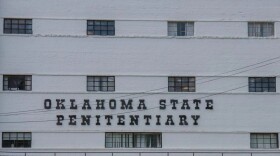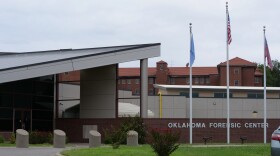Change is coming to a southeast Oklahoma private prison plagued with violence and staffing shortages, but advocates for corrections staff and prisoners say further efforts are needed to improve conditions.
The Oklahoma Department of Corrections will take control of the Davis Correctional Facility, a medium-to-maximum security prison in Holdenville, on Oct. 1. CoreCivic, a Tennessee-based private corrections company, has owned and operated the prison since it opened in 1996. The state pays CoreCivic $55 per day for medium-security prisoners and $68 per day for prisoners in maximum-security and behavior-modification units.
Corrections officers, medical personnel and other Davis staff will retain their salaries and start receiving state benefits, corrections department spokesperson Kay Thompson said. The Lawton Correctional Facility, owned and operated by The GEO Group, will remain as the state’s only private prison after the changeover.
“By taking over operations at DCF, we can more efficiently and effectively care for the men incarcerated there,” Department of Corrections Director Stephen Harpe said in a written statement. “We are changing lives in our facilities daily and want to continue to offer the same high standard of professionalism and respect to all Oklahoma inmates.”
Assaults against prisoners and staff inside Davis, which houses hundreds of high-risk offenders who are gang-affiliated or have been convicted of violent offenses, have spiked in recent years.
On July 31, 2022, Davis prisoner Gregory Thompson fatally stabbed 61-year-old corrections officer Alan Jay Hershberger. An Oklahoma Watch investigation published weeks after Hershberger’s death found that stabbings at the facility more than tripled from 2021 to 2022.
In late February, a prisoner fatally attacked another man housed at the facility with a homemade weapon. Another stabbing in mid-August prompted a lockdown and hospitalization of a prisoner.
Asked if the state takeover of Davis is related to the uptick in violence, Thompson said CoreCivic has been a good partner over the years but the agency believes it has the resources to better run and manage the facility. She said the corrections department has plans to establish new programs, possibly for job training or mental health, after an evaluation period.
“Everything has a season, and it’s time to move on from private facilities,” Thompson said.
Faced with a soaring prison population in the mid-1990s, Oklahoma officials turned to private companies to relieve overcrowding in state facilities. By early 2018, more than a third of the state’s male prison population was housed in a for-profit facility.
Criminal justice reform advocates have long pressed state leaders to cut ties with private prisons, raising concerns about conditions inside the facilities and the profit motive of the companies who run them. A Department of Justice investigation into federal private prisons released in 2016 found that the facilities tended to be more violent, less secure and not as effective in reforming prisoners as government-run facilities.
John Carl, a criminology professor at the University of Oklahoma who studies the U.S. prison system, told Oklahoma Watch in 2020 that private prisons tend to restrict prisoner movement and offer fewer programs than state or federally-run facilities.
“The easiest thing to do when managing a prison is to just keep it locked down all the time,” Carl said. “But eventually these people get out and they’re hot and they get into fights.”
Criminal justice reforms, most notably the voter-approved enactment of State Question 780 that reclassified several drug and property crimes from felonies to misdemeanors, have helped Oklahoma lower its prison population and reduce its reliance on private facilities. The state vacated the Cimarron Correctional Facility in Cushing in September 2020, citing decreased need for medium-security prison beds.
Emily Shelton, founder of the Oklahoma prisoner advocacy group Hooked on Justice, said the men housed at Davis and their loved ones should benefit from cheaper state rates for commissary items and phone calls. She said the transition also marks a win for justice reform advocates who have rallied against the privatization of prisons and jails for decades.
But implementing a culture change could prove difficult, said Shelton, whose son was previously incarcerated at Davis.
“At the end of the day, we still have the gang members in the prison,” she said. “All these deaths and overdoses, how drugs are coming in, none of that is going to change under DOC.”
Bobby Cleveland, a former state lawmaker and executive director of the Oklahoma Corrections Professionals group, said he’s concerned an expedited transition at Davis could further stress a prison system struggling to recruit and retain corrections officers.
Department of Corrections budget documents show the agency employed 1,277 state correctional officers as of April 30, down from 1,501 in March 2021. The Davis Correctional Facility operated at about 70% of its promised staffing level throughout 2021, according to documents obtained by The Associated Press.
“Right now we’re robbing Peter to pay Paul,” Cleveland said. “We take four officers out of one prison and send them to another one for a week or two to try and solve that. Well, that prison is now down. It’s a train wreck.”
State Rep. Justin Humphrey, a Republican from Lane who chairs the House Criminal Justice and Corrections Committee, said he doesn’t believe the state has received good service from private corrections companies and supports the effort to phase out for-profit prisons. But the former probation officer said he’s concerned corrections officials aren’t giving themselves enough time to evaluate the prison’s operations and condition and ensure a smooth transition.
He cited the recent state takeover of the Great Plains Correctional Facility, a former federal private prison that began housing Oklahoma prisoners in mid-May, as a cautionary tale.
“They had a lot of physical problems with the facility with things like doors and electric and phones,” Humphrey said. “When you move that quick, you also can have issues with food service and staffing. There are lots of issues we don’t have worked out of that yet, so I have concerns about jumping onto another facility.”
In a written statement, the Department of Corrections said operations at Davis will remain consistent with current CoreCivic practices immediately after the takeover.
Thompson, the corrections department spokesperson, said the agency is weighing a similar takeover of the Lawton Correctional Facility. Per the agreement inked between the agency and the GEO Group in June, the state could opt to purchase the 2,700-bed facility outright or terminate the contract altogether with at least 180 days’ notice.The Lawton prison, which houses about 12% of Oklahoma’s prison population, has its own violent history. On Aug. 16, a prisoner was airlifted to a hospital after a fight broke out. Four prisoners were taken to the hospital in mid-May after a large-scale fight broke out, local news station KSWO reported.
Oklahoma Watch, at oklahomawatch.org, is a nonprofit, nonpartisan news organization that covers public-policy issues facing the state.
Copyright 2023 KGOU. To see more, visit KGOU. 9(MDA4OTAxNzAzMDEzMjc0MTc2MzA5ZDZlMw004))








